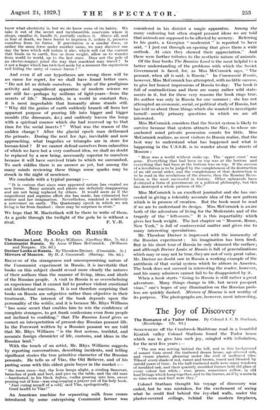The Joy of Discovery The Romance of a Tudor House.
By Colonel J. C. B. Statham. (Routledge. 12s. 6d.) SOMEWHERE off the Cranbrook-Maidstone road in a beautiful Kentish valley Colonel Statham found the Tudor house which was to give him such joy, mingled with tribulation,
for the next five years :—
"The sun was setting behind the hill, and in this background of sunset tints stood the timbered dream house, age-silvered oak, and cream plaster, gleaming under the roof of mellowed tiles. Tiles of every shade of red, russet and brown, toned and blended by untold years of tune. In the half-timbered walls were many windows of moulded oak, and their quaintly moulded frames held old glass of every colour but white ; rose, green, sometimes yellow, in old lead fittings which hung together, and to the frames, as if by a miracle so time-worn and frail were they."
Colonel Statham thought his voyage of discovery was ended, but he was mistaken, for the excitement of seeing what he could find behind the ivy-clad walls, under the plaster-covered ceilings, behind the modern fireplaces, under the surrounding earth and between the walls of this beautiful Tudor house prolonged his days of discovery into years of adventure and achievement.
Labour was scarce at the time when Colonel Statham bought his fifteenth-century half-timbered house, so he set about its restoration alone except for the help of two or three workmen in their overtime in the evenings. He writes with affection of every stone, beam and pane of glass which he helped to endow with its original utility and beauty, and his affection is catching, for he has enabled us to experience with him the delight he felt on finding the beautiful old fireplace, eight feet across and over three feet deep, behind the huge, hideous, red Victorian grate. The work of stripping
the plaster from the ceilings was exhausting and difficult :- ' but the glimpses one got of beautifully fashioned golden-brown oak beams encouraged me to go on working, and the occasional tinkle of coins, thimbles, and metal buttons ; the crack of falling marbles, gun-flints, and a host of other things, brought the excite- ment which compensated for the dust and drudgery."
Among the picturesque treasures which he found were two or three dolls—probably of Elizabethan date—which are "just pieces of wood with roughly shaped oval heads and two cloth arms attached or made entirely of cloth."
Colonel Statham's Tudor house was equipped with all the attributes which were essential to its romantic history. It had its hidden chamber, in which many an ardent soul may have sought shelter in the days of religious persecution, but which, since the days of Elizabeth, had probably been used as a refuse dump, for Elizabethan clothing and various other odds and ends were found amongst the layers of rubbish. The Manor House had also its ghost," sounds made at night— near midnight--like someone in pain. I have often heard them and, when mingled with the moaning of the wind in the great chimney, I can imagine that a nervous man or woman may have felt his flesh creep." The material explana- tion by which our author iccounts for this phenomenon is the one blow he strikes at his romantic home.
The Romance of a Tudor House is not by any means a list of
building operations : it is a record of five years' labour of love. Colonel Statham do&s not only tell us how he redeemed this old Manor House from inevitable decay ; he tells us what thoughts beguiled him while he worked ; he tells us, as he is hanging his big game trophies in the great barn, the stories of how those trophies were won ; as he laboriously places stone by stone while making his terraced garden, he describes to us well-remembered ruins whose construction has interested him in Africa ; as he wanders from room to room, he pictures for us the past lives which have been led in them ; as he strengthens the three large Elizabethan windows which are the glory of the house, he quotes from old chronicles.
We feel that the author has enjoyed writing the story of the
restoration of his Tudor House as much as he enjoyed the work itself. The story which he tells so delightfully will give pleasure to anyone who reads it, and the descriptions of the actual methods which he employed will no doubt be of the greatest assistance to those who feel inspired to make similar voyages of discovery.































 Previous page
Previous page